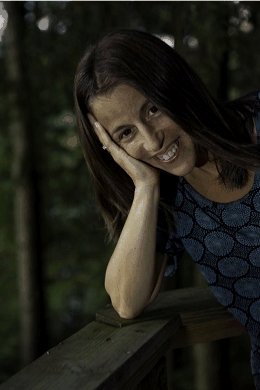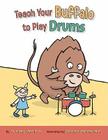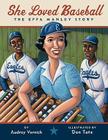
Laurie: Welcome, Audrey! Thanks for stopping by. Your first book, IS YOUR BUFFALO READY FOR KINDERGARTEN, was a light-hearted, hilariously funny book for the preschool set. Your second, SHE LOVED BASEBALL: THE EFFA MANLEY STORY, was a serious, passionate picture book biography. Now, here we are celebrating your return to young fiction with the release of TEACH YOUR BUFFALO TO PLAY DRUMS. (Congratulations!)

Laurie: One of the things that jumps out at me about all of your books is what a strong and unique voice they have, yet they’re totally different! As authors, we’re told, and often struggle, to find our own one true voice… but you’ve found two! How did you develop them? How do you switch back and forth between your BUFFALO voice and your nonfiction voice?
Audrey: I struggled with this question, because before I was published, I found it maddening the way people, especially editors, talked about voice. “It’s hard to define, but I know it when I see it.” THAT IS NOT HELPFUL! I want to give an informative answer, but the truth is that voice is the one part of the writing process that’s just there for me. I’m not at all conscious of developing voice or switching between voices. I write and it’s there.
Audrey: But as I think more about it, my brain keeps me pulling me back to the truly dreadful picture books I used to write, which had no voice at all. Before writing for kids, I wrote literary short fiction for adults (which makes writing for kids seem like a lucrative business decision). My voice was always in the short stories, but it did take me some time to get it into my children’s writing. A lot of time, actually. Something clicked into place with the buffalo books, and the best explanation I can give is that I learned to get out of my own way. I used to waste a lot of my narrative space explaining the world I created and why characters acted as they did. Now I state it and move on. And that, somehow, cleared out the room my voice had been waiting for.
Audrey: Lately I’ve been thinking a lot about voice in nonfiction. I really admire some voice-heavy nonfiction books, and I’m playing around with that, at least in my head, for the nonfiction project I’ve been working on for years. The examples that come to mind are both baseball books–Kadir Nelson’s WE ARE THE SHIP, about as perfect as a book could be (though maybe more for adult readers of children’s books than for children), and the wonderful YOU NEVER HEARD OF SANDY KOUFAX? by Jonah Winter (illustrated by Andre Carrilho). Those books deliver on three fronts, where I was only expecting two–information about a subject in which I was interested, gorgeous art, and the bonus: a really interesting voice to tell the story.
Laurie: You also have a novel coming out this fall. How did you find that voice, and how is it like or unlike the two we’ve already seen?
Audrey: The voice in WATER BALLOON is truest to… me. To who I am. Not necessarily who I was at thirteen, the age of the book’s narrator/protagonist, but who I am now, distilled back to a younger age.
Audrey: I started this book seven years ago and the voice was the exact same in the first sentence of the first draft as it was when I completed the final revision. But man alive, did I need to work on plot. If my characters had their way, they would lounge and emote for 300 pages.
Laurie: Another multi-talented author of both fiction and nonfiction (and fellow EMLA client) Chris Barton wrote in a guest post on Rasco from RIF, “I slide back and forth between fiction and nonfiction without really thinking much about it, my experiences with one building on the other. I suspect the youngest readers approach the two genres pretty much the same way—when you’ve explored only a smidge of the world, all books are about exploring more of it. It’s as we get older, as both readers and writers, that our tastes divide.”
Laurie: I guess, for some of us, our tastes never did divide. (Perhaps because we never grew up?) Do you have a preference? Which creative process do you enjoy more: fiction or nonfiction?
Audrey: I think writing funny comes more naturally and is more fun. Writing nonfiction is harder. But sometimes there’s a greater satisfaction in successfully completing a difficult task. And I feel something that’s found at the crossroads of pride and delight at sharing someone else’s story with a wide audience.
Audrey: I wouldn’t say I’m drawn to nonfiction as a whole, though. Some individual stories just call me. And while it’s obvious that some of them are baseball–in the case of my first book, BARK & TIM, it was a painting. I have likened seeing Tim Brown’s painting to the human-interest story I once read about a woman who saw a news story about an orphan in another country and had this immediate, strong knowledge: That’s my son. It was that strong when I saw “Feeding Bark.” That’s MY painting. My art. My story. For the playful, fiction books, I’m simply drawn in by the strong pull/desire to write something funny.
Laurie: Chris also wrote, “based on my own experiences slipping back and forth between genres, I believe they might even find inspiration for their next fiction project.”
Laurie: Do you also find that one informs the other? Do you need to do both to stay balanced? Where do you pull such different ideas from? Do you think they come from the same place somehow?
Audrey: Both kinds of stories—fiction and nonfiction—call to me. I don’t go seeking story ideas. I find myself wondering about something or someone (nonfiction) and wanting to explore to find out more. Usually in the case of fiction picture books, I say something, though sometimes I just think it, and it echoes until I start looking at it for story potential. The closest I’ve come to one informing the other was when reading a particular kind of nonfiction picture book—the spate of inter-species friendship books—led to writing a fiction spoof of the genre, the upcoming BOGART & VINNIE.
Laurie: Do you tend to work on fiction projects and nonfiction projects at the same time? Or do you keep them completely separate?
Audrey: I work on them simultaneously. I don’t have any trouble switching gears, for the most part.
Laurie: How is your process different for something like TEACH YOUR BUFFALO TO PLAY DRUMS and SHE LOVED BASEBALL?
Audrey: I just need an idea to start writing fiction picture books. A title, a premise, a character–those have all been my starting points for different fiction picture books. For nonfiction, I need a lot of information. I need interviews, background information, etc. And I need time for the story to boil down enough that I can envision an opening scene, where an opening scene almost always naturally emerges for me when writing fiction picture books.
Audrey: When I get stuck writing nonfiction, it’s usually a good hint that I need to do more research. When I’m stuck writing fiction, it’s kind of my own problem to fix. After waiting a few days to see if an answer comes to me, I’ll sometimes try to sit down and write five possible ways out. This usually works. One thing I’ve done when stuck writing both fiction and nonfiction, with success, is talk it through with smart people.
Audrey: The editing process is similar in that both are almost always about stripping away to find the essential story. With nonfiction, it’s wrenching, because you’re cutting away parts of a life. I still mourn for a scene in SHE LOVED BASEBALL. I find it more satisfying with fiction, because for me, my humor usually comes through best when it’s in a stark, brief form. But that’s not how I write it–that happens in revision.
Laurie: What are you working on now?
Audrey: I am revising a recently acquired picture book entitled BOGART & VINNIE, A COMPLETELY MADE-UP STORY OF TRUE FRIENDSHIP. I find myself in the new-to-me situation of turning a character from a potbellied pig into a rhinoceros.
Audrey: I’m also planning to start a new upper middle-grade novel this summer, which scares me more than any other kind of writing. Novels are so consuming and, for me, really hard! I know a lot about my main character and her situation, about where she starts and where she’ll end up, but getting her to move and do things has proven to be a challenge.
Audrey: Mixed in there are a couple of other picture book projects–mostly fiction, with one nonfiction–that I return to every now and then. And one new one that’s just starting to scratch its way to the surface.
Laurie: What do you most want people to know about you as an author and as a person?
Audrey: That is a big question.
Audrey: I’m a big reader. The moments I love best as a reader are the ones that make me laugh, or the ones I HAVE to read aloud or paste into an email for someone else whom I know will get it exactly as I do, or stumbling upon phrasing that pleases me to my core. Most recently, it was this sentence in Ann Patchett’s STATE OF WONDER, when a character receives bad news: “There was inside of her a very modest physical collapse, not a faint but a sort of folding, as if she were an extension ruler and her ankles and knees and hips were all being brought together at closer angles.” It’s not an especially important moment in the book, but those words evoked something in me. I reread them several times, with great satisfaction and pleasure.
Audrey: As a writer, I don’t think there’s any way to consciously strive for such moments in our own writing. But I think that’s why I write–in the hope that I might provide that kind of moment for a reader.
Audrey: As a person, boy that’s hard. When my sisters and I describe people, we always find ourselves falling upon the same rubric of funny, smart, and nice. They claim they haven’t, but I believe they have, more than once, subtly suggested that I might want to work a bit on the nice part. I am a strange combination of misanthrope and someone exceedingly fond of and loyal to the core of people I adore.
Laurie: Thanks so much, Audrey! I can’t wait to see TEACH YOUR BUFFALO TO PLAY DRUMS and all of your other upcoming projects.
Read on about Audrey, the buffalo, and more on the rest of her summer 2011 blog tour:
- Audrey Vernick on Brainstorming and The Bufflalo’s Bucket List on Jean Reidy’s blog
- The Wednesday Interview: 3 Questions For Audrey Vernick on Peter Adam Solomon’s blog
- And stay tuned for the next stop, which will be on Ruth McNally Barshaw’s blog.



